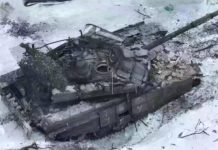The Russian self-propelled anti-aircraft gun ZSU-23-4 Shilka, developed in the 1960s, is also present on the Donbass front line.
The war in Ukraine has seen the success of drones, cruise missiles, or artillery. Low-altitude air defense systems are being rushed to Ukraine to deal with new threats. The Russian self-propelled anti-aircraft gun ZSU-23-4 Shilka, developed in the 1960s, is also present on the Donbass front line. Although not the most advanced weapon of this day, with a maximum rate of fire of up to 4,000 rounds per minute, Shilka still has a certain place in low-altitude air defense and urban warfare.

The ZSU-23-4 Shilka first appeared to the public during a military parade in Moscow in November 1965. The system was widely fielded throughout the Warsaw Pact and among other pro-Soviet states. Around 2,500 ZSU-23-4s, of the total 6,500 produced, were exported to 23 countries. The Warsaw Pact’s successor states continue to manufacture and supply variants of the ZSU-23-4, notably the Ukrainian “Donets” and Polish “Biala” variants.
Shilka is designed to protect the combat forces of troops, columns on the march, stationary objects and railway trains from attacking an air enemy at altitudes from 100 to 1500 meters, at ranges from 200 to 2500 meters at target speeds up to 450 m/s. “Shilka” was a breakthrough in the field of destruction of flying targets at low altitudes. Plus mobility, which is already rated by ZSU-57-2. But the main thing is accuracy.
The armament of the complex consists of the 23-mm quad automatic anti-aircraft cannon AZP-23 “Amur” and a system of power drives designed for targeting. The second component of the complex is the radar-instrument complex RPK-2М, for guidance and fire control. Shilka can work both with radar and with conventional optical sight aiming device. Locator provides search, detection, automatic tracking of the target, determines its coordinates.

The air defense system is mounted on a GM-575 tracked chassis, using parts from the PT-76 light amphibious tank. The engine and the transmission are at the rear of the hull as is the DG4M-1 gas turbine coupled to a manual gearbox with 5 forwards and 1 reverse gears. The torsion bar suspension system consists of six single rubber-tired road wheels with the idler at the front and the drive sprocket at the rear. There are no track return rollers. Thin armor of the ZSU-23-4 provides only limited protection against small arms fire and artillery shell splinters. Vehicle is fitted with NBC protection system.
The crew of the Shilka consists of four people: the commander, the search-gunner operator, the range operator and the driver. The guns and ammunition are in the forward part of the turret and separated from the crew by a gas-tight and armored bullhead. The ZSU-23-4 Shilka can engage targets using only one or two of the four canons.

The ZSU-23-4 proved highly effective during the 1973 Middle East war and accounted for a large number of Israeli aircraft losses. The ZSU-23-4 was also used in both North and South Vietnam and in the Arabian Gulf war by the Iranian and the Iraqis.
At the present time ZSU-23-4 cannot be compared with new generation low-altitude air defense systems, but it is still very useful in terms of fire support, and plays a larger role in urban warfare. However, ZSU-23-4 also has a weak point, which is thin armor. This requires infantry and tanks, to protect the ZSU-23-4 well during combat.






















